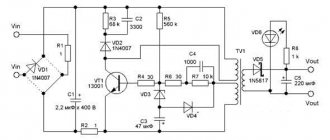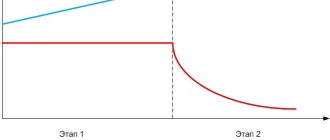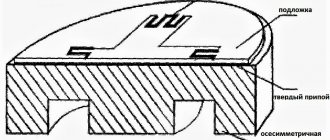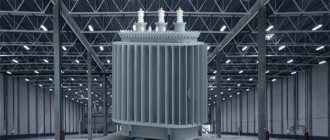In the second half of the 40s, before work was completed on creating the first atomic bomb, which was tested on August 29, 1949, Soviet scientists began developing the first projects for the peaceful use of atomic energy. The main focus of the projects was electricity.
In May 1950, near the village of Obninskoye, Kaluga Region, construction began on the world's first nuclear power plant.
Electricity was first produced using a nuclear reactor on December 20, 1951 in the state of Idaho in the USA.
To test its functionality, the generator was connected to four incandescent lamps, but I did not expect the lamps to light up.
From that moment on, humanity began to use the energy of a nuclear reactor to produce electricity.
First Nuclear Power Plants
The construction of the world's first nuclear power plant with a capacity of 5 MW was completed in 1954 and on June 27, 1954 it was launched, which is how the Obninsk NPP began to operate.
In 1958, the 1st stage of the Siberian Nuclear Power Plant with a capacity of 100 MW was put into operation.
Construction of the Beloyarsk industrial nuclear power plant also began in 1958. On April 26, 1964, the 1st stage generator supplied current to consumers.
In September 1964, the 1st unit of the Novovoronezh NPP with a capacity of 210 MW was launched. The second unit with a capacity of 350 MW was launched in December 1969.
In 1973, the Leningrad Nuclear Power Plant was launched.
In other countries, the first industrial nuclear power plant was commissioned in 1956 at Calder Hall (Great Britain) with a capacity of 46 MW.
In 1957, a 60 MW nuclear power plant came into operation in Shippingport (USA).
The world leaders in nuclear power production are:
- USA (788.6 billion kWh/year),
- France (426.8 billion kWh/year),
- Japan (273.8 billion kWh/year),
- Germany (158.4 billion kWh/year),
- Russia (154.7 billion kWh/year).
Uranium fuel
Uranium is a silvery-white, glossy, high-density metal. Three isotopes occur in nature: U-238 (abundance = 99.2745%), U-235 (0.72%), U-234 (0.055). The fuel used in nuclear power plants is U-235 as a material that can independently support a nuclear chain reaction. But its natural content in the feedstock is low, so it is necessary to engage in artificial enrichment (increasing the content of the 235th isotope in the fuel).
Russia has 9% of the world's proven reserves of nuclear fuel (a little over half a million tons). The extraction of such irreplaceable raw materials for the nuclear industry in our country is carried out by the ARMZ (Atomredmetzoloto) Uranium Holding. 90% of uranium in Russia comes from the Krasnokamensk Mining and Chemical Association.
Foreign assets are represented by Uranium One, a division of our domestic state corporation, which owns production facilities in the USA, Canada, South Africa, Kazakhstan, and Australia. There is an agreement to participate in the development of the Mardai field in Mongolia.
Our country has a fully completed cycle of uranium enrichment capacity sufficient to supply every sixth reactor in the world with its products. The most advanced modern technology is based on the gas centrifuge method. Unites all enrichment enterprises and organizations Toplivnaya - the absolute monopolist of nuclear fuel production in Russia.
NPP classification
Nuclear power plants can be classified in several ways:
By reactor type
- Thermal neutron reactors that use special moderators to increase the likelihood of neutron absorption by the nuclei of fuel atoms
- Light water reactors
- Heavy water reactors
- Fast reactors
- Subcritical reactors using external neutron sources
- Fusion reactors
By type of energy released
- Nuclear power plants (NPPs) designed to generate only electricity
- Nuclear combined heat and power plants (CHPs), generating both electricity and thermal energy
At nuclear power plants located in Russia there are heating installations; they are necessary for heating network water.
Beloyarsk NPP. Twice pioneer
So, now let's move on to operating nuclear power plants. The first of them is the Beloyarsk Nuclear Power Plant, 20 km from where I live. This is my favorite nuclear power plant, which I have visited many times. After Obninsk, this was the first large civil nuclear power plant, i.e. not dual-use and not on the territory of a nuclear plant. It was built specifically to generate electricity and heat and was not used to produce plutonium. Its fuel was not even processed, which, oddly enough, I also have a separate article about.
The nuclear power plant came into operation in 1964. The total power of the two reactors of the first stage of the station was 300 MW. These reactors were called AMB, which stands for “Atom Peaceful Big,” which reflects their purpose. These are also channel uranium-graphite reactors, but of an improved design. They tried to increase efficiency due to additional superheating of the steam. Those. In addition to the channels with fuel and water, which removed heat from the core, steam was additionally passed through the reactor through some channels before it was sent to the turbine to increase its pressure in order to improve the efficiency of the entire installation. The first power unit with a capacity of 100 MW operated on a dual-circuit scheme. The second power unit operated according to a simplified single-circuit scheme, where steam was generated directly in the first circuit of the reactor, then heated again in the reactor and then went to the turbine; its power was already 200 MW. In the future, such a single-circuit scheme, albeit without steam overheating, will form the basis of powerful RBMK reactors. The efficiency of the first stage of the Beloyarsk NPP reached 37%, and this is several percent more than that of many modern nuclear power plants.
The reactors of the first stage exhausted their service life and were stopped by 1989. Now the nuclear power plant operates two new reactors with a completely different design - these are fast neutron reactors.
Power units of the Beloyarsk NPP. Infographics by the author
Since 1980, the Beloyarsk NPP has operated a BN-600 reactor, and since 2015, a BN-800 reactor. 600 and 800 are the design electrical power of these reactors, although in fact it has been increased by almost 10%. These are the only fast neutron nuclear power reactors in the world at the moment. Thanks to them, although there were others of smaller capacity, our country has accumulated the greatest experience in operating fast reactors, which can form the basis or a significant share of nuclear energy in the future. Of course, they need to devote separate articles and videos.
I will only say about the main feature. These are reactors in which the main fission of heavy nuclei is carried out by fast neutrons. I partially described what this is in a previous article about reactors with spectral regulation. Fast reactors make it possible to involve into the fuel cycle not only uranium-235, of which natural uranium contains only 0.7%, but also the main isotope uranium-238, of which there is more than 99%. They also make it possible to close the fuel cycle, using as fuel what is unloaded from other reactors. The BN-800 is already being converted to full loading with MOX fuel, which does not require the extraction of natural uranium. It is made from plutonium separated from spent fuel from other reactors and from stockpiles of depleted uranium.
I also have a separate article about depleted waste uranium and MOX fuel, and even a whole series of articles, if we talk in general about the problem of depleted uranium hexafluoride, which is periodically imported to us from abroad amid the noise of anti-nuclear environmental activists.
Reactor BN-800
For a long time, the Beloyarsk NPP was the only station in our country that operated reactors of different types - channel uranium-graphite AMB and fast sodium BN. Now the Leningrad NPP can be classified as such a station, because both RBMK and VVER are operating there at the same time, but we will get to that.
Types of fuel used at Nuclear Power Plants
At nuclear power plants, it is possible to use several substances, thanks to which it is possible to generate nuclear electricity; modern nuclear power plant fuels are uranium, thorium and plutonium.
Thorium fuel is not used in nuclear power plants today, for a number of reasons.
Firstly , it is more difficult to convert it into fuel elements, abbreviated fuel elements.
Fuel rods are metal tubes that are placed inside a nuclear reactor. Inside
Fuel elements contain radioactive substances. These tubes are nuclear fuel storage facilities.
Secondly , the use of thorium fuel requires its complex and expensive processing after use at nuclear power plants.
Plutonium fuel is also not used in nuclear power engineering, due to the fact that this substance has a very complex chemical composition, a system for full and safe use has not yet been developed.
Uranium fuel
The main substance that produces energy at nuclear power plants is uranium. Today, uranium is mined in several ways:
- open pit mining
- locked in mines
- underground leaching, using mine drilling.
Underground leaching, using mine drilling, occurs by placing a sulfuric acid solution in underground wells, the solution is saturated with uranium and pumped back out.
The largest uranium reserves in the world are located in Australia, Kazakhstan, Russia and Canada.
The richest deposits are in Canada, Zaire, France and the Czech Republic. In these countries, up to 22 kilograms of uranium raw material are obtained from a ton of ore.
In Russia, a little more than one and a half kilograms of uranium is obtained from one ton of ore. Uranium mining sites are non-radioactive.
In its pure form, this substance is of little danger to humans; a much greater danger is the radioactive colorless gas radon, which is formed during the natural decay of uranium.
Uranium preparation
Uranium is not used in the form of ore in nuclear power plants; the ore does not react. To use uranium at nuclear power plants, the raw material is processed into powder - uranium oxide, and after that it becomes uranium fuel.
Uranium powder is turned into metal “tablets” - it is pressed into small neat flasks, which are fired during the day at temperatures above 1500 degrees Celsius.
It is these uranium pellets that enter nuclear reactors, where they begin to interact with each other and, ultimately, provide people with electricity.
About 10 million uranium pellets are working simultaneously in one nuclear reactor.
Before placing uranium pellets in the reactor, they are placed in metal tubes made of zirconium alloys - fuel elements; the tubes are connected to each other into bundles and form fuel assemblies - fuel assemblies.
It is the fuel assemblies that are called nuclear power plant fuel.
Fukushima
This is another example of a global disaster involving a nuclear power plant. And in this case, too, the cause was a chain of accidents. The station was reliably protected from earthquakes and tsunamis, which are not uncommon on the Japanese coast. Few could have imagined that both of these events would occur simultaneously. The operating principle of the Fukushima NPP generator involved the use of external energy sources to maintain the entire safety complex in operation. This is a reasonable measure, since it would be difficult to obtain energy from the plant itself during an accident. Due to the earthquake and tsunami, all these sources failed, causing the reactors to melt down and cause a disaster. Efforts are now underway to repair the damage. According to experts, this will take another 40 years.
How does nuclear power plant fuel reprocess?
After a year of using uranium in nuclear reactors, it must be replaced.
Fuel elements are cooled for several years and sent for chopping and dissolution.
As a result of chemical extraction, uranium and plutonium are released, which are reused and used to make fresh nuclear fuel.
The decay products of uranium and plutonium are used to manufacture sources of ionizing radiation; they are used in medicine and industry.
Everything that remains after these manipulations is sent to the furnace for heating, glass is made from this mass, such glass is stored in special storage facilities.
Top 10 nuclear power plants by power
The largest nuclear power plants in the world. Rating of the top 10 nuclear power plants by power. Most of the largest nuclear power plants ... “Read more”
Glass is not made from the residues for mass use; glass is used to store radioactive substances.
It is difficult to extract from glass the remains of radioactive elements that can harm the environment. Recently, a new way to dispose of radioactive waste has emerged.
Fast nuclear reactors or fast neutron reactors, which operate on reprocessed nuclear fuel residues.
According to scientists, the remains of nuclear fuel, which are currently stored in storage facilities, are capable of providing fuel for fast neutron reactors for 200 years.
In addition, new fast reactors can operate on uranium fuel, which is made from uranium 238; this substance is not used in conventional nuclear power plants, because It is easier for today’s nuclear power plants to process 235 and 233 uranium, of which there is little left in nature.
Thus, new reactors are an opportunity to use huge deposits of 238 uranium, which have not been used before.
Main problems of nuclear power
There is one significant environmental problem associated with the development of nuclear energy. This is the so-called thermal pollution of the environment. Thus, according to many experts, nuclear power plants emit more heat than thermal power plants of the same power. Particularly dangerous is thermal water pollution, which disrupts the natural living conditions of biological organisms and leads to the death of many species of fish.
Another pressing issue associated with nuclear energy concerns nuclear safety in general. For the first time, humanity seriously thought about this problem after the Chernobyl disaster in 1986. The operating principle of the Chernobyl nuclear power plant was not much different from that of other nuclear power plants. However, this did not save her from a major and serious accident, which entailed very serious consequences for the entire Eastern Europe.
Moreover, the danger of nuclear energy is not limited to possible man-made accidents. Thus, big problems arise with the disposal of nuclear waste.
Operating principle of nuclear power plants
The operating principle of a nuclear power plant based on a double-circuit pressurized water reactor (VVER).
The energy released in the reactor core is transferred to the primary coolant.
Next, the coolant enters the heat exchanger (steam generator), where it heats the secondary circuit water to a boil. The resulting steam enters turbines that rotate electric generators.
At the exit of the turbines, the steam enters the condenser, where it is cooled by a large amount of water coming from the reservoir.
The pressure compensator is a rather complex and cumbersome structure that serves to equalize pressure fluctuations in the circuit during reactor operation that arise due to thermal expansion of the coolant. The pressure in the 1st circuit can reach up to 160 atmospheres (VVER-1000).
In addition to water, molten sodium or gas can also be used as a coolant in various reactors.
The use of sodium makes it possible to simplify the design of the reactor core shell (unlike the water circuit, the pressure in the sodium circuit does not exceed atmospheric pressure), and to get rid of the pressure compensator, but it creates its own difficulties associated with the increased chemical activity of this metal.
The total number of circuits may vary for different reactors, the diagram in the figure is shown for reactors of the VVER type (Water-Water Energy Reactor).
Reactors of the RBMK type (High Power Channel Type Reactor) use one water circuit, and BN reactors (Fast Neutron Reactor) use two sodium and one water circuits.
If it is not possible to use a large amount of water for steam condensation, instead of using a reservoir, the water can be cooled in special cooling towers, which due to their size are usually the most visible part of a nuclear power plant.
A few facts about nuclear reactors...
It’s interesting that one nuclear power plant reactor takes at least 3 years to build! To build a reactor, you need equipment that operates on an electric current of 210 kiloamperes, which is a million times higher than the current that can kill a person.
One shell (structural element) of a nuclear reactor weighs 150 tons. There are 6 such elements in one reactor.
Pressurized water reactor
We have already found out how a nuclear power plant works in general; to put everything into perspective, let’s look at how the most popular pressurized water nuclear reactor works. All over the world today, generation 3+ pressurized water reactors are used. They are considered the most reliable and safe.
All pressurized water reactors in the world, over all the years of their operation, have already accumulated more than 1000 years of trouble-free operation and have never given serious deviations.
The structure of nuclear power plants using pressurized water reactors implies that distilled water heated to 320 degrees circulates between the fuel rods. To prevent it from going into a vapor state, it is kept under pressure of 160 atmospheres. The nuclear power plant diagram calls it primary circuit water.
The heated water enters the steam generator and gives up its heat to the secondary circuit water, after which it “returns” to the reactor again. Outwardly, it looks like the water tubes of the first circuit are in contact with other tubes - the water of the second circuit, they transfer heat to each other, but the waters do not come into contact. The tubes are in contact.
Thus, the possibility of radiation entering the secondary circuit water, which will further participate in the process of generating electricity, is excluded.
The way nuclear power plants operate is already well known - secondary circuit water in steam generators turns into steam, the steam rotates a turbine, and the turbine drives an electric generator, which generates electricity.
Nuclear reactor structure
A nuclear reactor uses a nuclear fission process in which a heavy nucleus breaks into two smaller fragments.
These fragments are in a highly excited state and emit neutrons, other subatomic particles and photons.
Neutrons can cause new fissions, resulting in more of them being emitted, and so on.
Such a continuous self-sustaining series of splittings is called a chain reaction.
This releases a large amount of energy, the production of which is the purpose of using nuclear power plants.
The operating principle of a nuclear reactor and nuclear power plant is such that about 85% of the fission energy is released within a very short period of time after the start of the reaction.
The rest is produced by the radioactive decay of fission products after they have emitted neutrons.
Radioactive decay is a process in which an atom reaches a more stable state. It continues after division is completed.
History and features of nuclear energy
“Energy is the head of everything” - this is how one can paraphrase the famous proverb, taking into account the objective realities of the 21st century. With each new round of technological progress, humanity needs more and more of it. Today, the energy of the “peaceful atom” is actively used in the economy and production, and not only in the energy sector.
Electricity produced at so-called nuclear power plants (the operating principle of which is very simple in nature) is widely used in industry, space exploration, medicine and agriculture.
Nuclear energy is a branch of heavy industry that extracts heat and electricity from the kinetic energy of an atom.
When did the first nuclear power plants appear? Soviet scientists studied the operating principle of such power plants back in the 40s. By the way, at the same time they invented the first atomic bomb. Thus, the atom was both “peaceful” and deadly.
In 1948, I.V. Kurchatov proposed that the Soviet government begin to carry out direct work on the extraction of atomic energy. Two years later in the Soviet Union (in the city of Obninsk, Kaluga region), construction of the very first nuclear power plant on the planet begins.
The operating principle of all nuclear power plants is similar, and understanding it is not at all difficult. This will be discussed further.
Operating principle of a nuclear reactor
In the reactor core there are fuel elements (fuel elements) - nuclear fuel.
They are assembled into cassettes containing several dozen fuel rods. The coolant flows through the channels through each cassette.
Fuel rods regulate the power of the reactor. A nuclear reaction is possible only at a certain (critical) mass of the fuel rod.
The mass of each rod individually is below critical. The reaction begins when all the rods are in the active zone. By inserting and removing fuel rods, the reaction can be controlled.
So, when the critical mass is exceeded, radioactive fuel elements emit neutrons that collide with atoms.
As a result, an unstable isotope is formed, which immediately decays, releasing energy in the form of gamma radiation and heat.
Particles colliding impart kinetic energy to each other, and the number of decays increases exponentially.
This is a chain reaction - the principle of operation of a nuclear reactor. Without control, it occurs at lightning speed, which leads to an explosion. But in a nuclear reactor the process is under control.
Thus, thermal energy is released in the core, which is transferred to the water washing this zone (primary circuit).
Here the water temperature is 250-300 degrees. Next, the water transfers heat to the second circuit, and then to the turbine blades that generate energy.
The conversion of nuclear energy into electrical energy can be represented schematically:
- Internal energy of a uranium nucleus
- Kinetic energy of fragments of decayed nuclei and released neutrons
- Internal energy of water and steam
- Kinetic energy of water and steam
- Kinetic energy of turbine and generator rotors
- Electric Energy
The reactor core consists of hundreds of cassettes united by a metal shell. This shell also plays the role of a neutron reflector.
Control rods for adjusting the reaction speed and reactor emergency protection rods are inserted among the cassettes.
Next, thermal insulation is installed around the reflector. On top of the thermal insulation there is a protective shell made of concrete, which traps radioactive substances and does not allow them to pass into the surrounding space.
Safety
The list of radiation accidents in the world, which began on December 12, 1952 (Chalk River Laboratory) to August 8, 2022 (Russian Navy Nenoksa training ground), includes 22 incidents. In addition, 7 cases of radioactive contamination of the area were recorded.
Issues of accident-free operation at nuclear energy enterprises, proper handling of waste, spent fuel, problems of conservation, liquidation of nuclear military and industrial facilities have now become very relevant.
Control of the activities of hazardous production facilities (which include nuclear power plants) is carried out by Rostechnadzor. He has at his disposal a number of documents regulating the state of security.
2018-2019 brought Rosatom among the leaders in environmental safety. This is not surprising, since nuclear energy has always been the most environmentally friendly sector of energy production. Work is underway to create safer reactors and locate nuclear power plants in earthquake-resistant zones. The state corporation is entrusted with the responsibility to organize the elimination of chemical weapons and build complexes for the disposal of emergency waste.
Nuclear heat supply station
The first projects of such stations were developed back in the 70s of the 20th century, but due to the economic upheavals that occurred in the late 80s and severe public opposition, none of them were fully implemented.
The exception is the Bilibino nuclear power plant of small capacity; it supplies heat and electricity to the village of Bilibino in the Arctic (10 thousand inhabitants) and local mining enterprises, as well as defense reactors (they produce plutonium):
- Siberian nuclear power plant, supplying heat to Seversk and Tomsk.
- The ADE-2 reactor at the Krasnoyarsk Mining and Chemical Combine, which has been supplying thermal and electrical energy to the city of Zheleznogorsk since 1964.
At the time of the crisis, the construction of several ASTs based on reactors similar to VVER-1000 had begun:
- Voronezh AST
- Gorky AST
- Ivanovo AST (only planned)
Construction of these ASTs was stopped in the second half of the 1980s or early 1990s.
In 2006, the Rosenergoatom concern planned to build a floating nuclear power plant for Arkhangelsk, Pevek and other polar cities based on the KLT-40 reactor plant, used on nuclear icebreakers.
There is a project for the construction of an unattended nuclear power plant based on the Elena reactor, and a mobile (by rail) Angstrem reactor plant.
Kalinin NPP. Serial VVER-1000
Kalinin NPP
Let's move on to three nuclear power plants with serial gigawatt VVER units. The first of them is the Kalinin NPP with four VVER-1000 units. Located in the Tver region, near the city of Udomlya. This is the closest operating nuclear power plant to Moscow - 350 km in a straight line. Its first units started operating in 1984 and 1986, although they are not the most popular VVER-1000 series - the V-338 modification. The second stage of the station, with serial VVER-1000 of the most popular modification V-320, was built already in the 21st century - in 2004 and in 2011.
Kalinin Nuclear Power Plant and view of the city of Udomlya. Blocks 3 and 4 are closer to us. Next are blocks 1 and 2.
It was their construction that I followed when I was studying at the Faculty of Physics and Technology to become a nuclear physicist. At that time, Russia did not build many new power units. By the way, I had a chance to visit the Kalinin NPP in 2017. And since this was the first large nuclear power plant with four gigawatt units that I visited, I was struck by the scale of the station itself, starting from the entrance - yet it employs more than 3,000 people. This is a truly huge enterprise that produces about 3% of the country’s total electricity. The Beloyarsk Nuclear Power Plant, which is close to me, is much more compact, intimate and, I would even say, more comfortable.
Disadvantages and advantages of nuclear power plants
Any engineering project has its positive and negative sides.
Positive aspects of nuclear power plants:
- No harmful emissions;
- Emissions of radioactive substances are several times less than coal electricity. stations of similar power (coal ash thermal power plants contain a percentage of uranium and thorium sufficient for their profitable extraction);
- Small volume of fuel used and the possibility of its reuse after processing;
- High power: 1000–1600 MW per power unit;
- Low cost of energy, especially thermal energy.
Negative aspects of nuclear power plants:
- Irradiated fuel is dangerous and requires complex and expensive reprocessing and storage measures;
- Variable power operation is not desirable for thermal neutron reactors;
- The consequences of a possible incident are extremely severe, although its probability is quite low;
- Large capital investments, both specific, per 1 MW of installed capacity for units with a capacity of less than 700-800 MW, and general, necessary for the construction of the station, its infrastructure, as well as in the event of possible liquidation.
Emissions into the atmosphere through a nuclear power plant chimney
Probably the largest number of rumors and conjectures surround emissions from nuclear power plants. There really are emissions and they occur mainly through ventilation pipes - these are the same pipes that stand near each power unit and never smoke. For the most part, inert radioactive gases - xenon, krypton and argon - enter the atmosphere. But before being released into the atmosphere, air from the premises of a nuclear power plant passes through a system of complex filters, where most of the radionuclides are removed. Short-lived isotopes decay before the gases reach the top of the pipe, further reducing radioactivity. As a result, the contribution to the natural radiation background of gas and aerosol emissions from nuclear power plants into the atmosphere is insignificant and can be completely neglected. Therefore, nuclear energy is one of the cleanest in comparison with other power plants. In any case, all radioactive emissions from nuclear power plants are strictly controlled by environmentalists, and ways to further reduce them are being developed.
Scientific developments in the field of nuclear energy
Of course, there are shortcomings and concerns, but nuclear energy seems to be the most promising.
Alternative methods of obtaining energy, due to the energy of tides, wind, sun, geothermal sources, etc., currently do not have a high level of energy received, and its low concentration.
The necessary types of energy production have individual risks for the environment and tourism, for example, the production of photovoltaic cells, which pollutes the environment, the danger of wind farms for birds, and changes in wave dynamics.
Scientists are developing international projects for new generation nuclear reactors, for example GT-MGR, which will improve safety and increase the efficiency of nuclear power plants.
Russia has begun construction of the world's first floating nuclear power plant, which helps solve the problem of energy shortages in remote coastal areas of the country.
The USA and Japan are developing mini-nuclear power plants with a capacity of about 10-20 MW for the purpose of heat and power supply to individual industries, residential complexes, and in the future - individual houses.
A decrease in plant capacity implies an increase in production scale. Small-sized reactors are created using safe technologies that greatly reduce the possibility of nuclear leakage.
Hydrogen production
The US government has adopted the Atomic Hydrogen Initiative. Together with South Korea, work is underway to create a new generation of nuclear reactors capable of producing large quantities of hydrogen.
INEEL (Idaho National Engineering Environmental Laboratory) predicts that one unit of the next generation nuclear power plant will produce hydrogen equivalent to 750,000 liters of gasoline daily.
Research into the feasibility of producing hydrogen at existing nuclear power plants is being funded.
Fusion energy
An even more interesting, although relatively distant, prospect is the use of nuclear fusion energy.
Thermonuclear reactors, according to calculations, will consume less fuel per unit of energy, and both this fuel itself (deuterium, lithium, helium-3) and the products of their synthesis are non-radioactive and, therefore, environmentally safe.
Currently, with the participation of Russia, the construction of the international experimental thermonuclear reactor ITER is underway in the south of France.
Development of nuclear energy in different countries
Overall, as of 2014, there has been a general decline in the development of nuclear energy. The leaders in the construction of new nuclear reactors are three countries: Russia, India and China. In addition, a number of states that do not have nuclear power plants are planning to build them in the near future. These include Kazakhstan, Mongolia, Indonesia, Saudi Arabia and a number of North African countries.
On the other hand, a number of states have taken a course towards gradually reducing the number of nuclear power plants. These include Germany, Belgium and Switzerland. And in some countries (Italy, Austria, Denmark, Uruguay) nuclear energy is prohibited by law.
Nuclear power plant efficiency
The highest efficiency (92-95%) is the advantage of hydroelectric power plants. They generate 14% of the world's electrical power.
However, this type of station is the most demanding regarding the construction site and, as practice has shown, is very sensitive to compliance with operating rules.
The example of the events at the Sayano-Shushenskaya HPP showed what tragic consequences can result from neglecting operating rules in an effort to reduce operating costs.
Nuclear power plants have high efficiency (80%). Their share in global electricity production is 22%.
But nuclear power plants require increased attention to the safety issue, both at the design stage, during construction, and during operation.
The slightest deviation from strict safety regulations for nuclear power plants is fraught with fatal consequences for all humanity.
An example of this is the Chernobyl nuclear power plant accident and the Japanese earthquake in March 2011, which led to an accident at a nuclear power plant located on the island of Honshu, in the city of Okuma, Fukushima Prefecture.
In addition to the immediate danger in the event of an accident, the use of nuclear power plants is accompanied by safety problems associated with the disposal or disposal of spent nuclear fuel.
The efficiency of thermal power plants does not exceed 34%; they generate up to sixty percent of the world's electricity.
In addition to electricity, thermal power plants produce thermal energy, which in the form of hot steam or hot water can be transmitted to consumers over a distance of 20-25 kilometers. Such stations are called CHP (Heat Electric Central).
TPPs and combined heat and power plants are not expensive to build, but unless special measures are taken, they have an adverse impact on the environment.
The adverse impact on the environment depends on what fuel is used in thermal units.
The most harmful products are the combustion of coal and heavy oil products; natural gas is less aggressive.
Thermal power plants are the main sources of electricity in Russia, the USA and most European countries.
However, there are exceptions, for example, in Norway, electricity is generated mainly by hydroelectric power plants, and in France, 70% of electricity is generated by nuclear power plants.
Catastrophe of the 21st century and its consequences
Fukushima I
In March 2011, an earthquake struck northeastern Japan, causing a tsunami that ultimately damaged 4 of the 6 reactors at the Fukushima I nuclear power plant.
Less than two years after the tragedy, the official death toll in the disaster exceeded 1,500 people, while 20,000 people are still missing and another 300,000 residents were forced to leave their homes.
There were also victims who were unable to leave the scene due to the huge dose of radiation. An immediate evacuation was organized for them, which lasted 2 days.
However, every year, methods for preventing accidents at nuclear power plants, as well as neutralizing emergencies, are being improved - science is steadily moving forward. However, the future will clearly be a time for the flourishing of alternative methods of generating electricity - in particular, it is logical to expect the appearance in the next 10 years of gigantic orbital solar panels, which is quite achievable in conditions of weightlessness, as well as other, including revolutionary technologies in the energy sector.
The first power plant in the world
The very first central power plant, the Pearl Street, was commissioned on September 4, 1882 in New York City.
The station was built with the support of the Edison Illuminating Company, which was headed by Thomas Edison.
Several Edison generators with a total capacity of over 500 kW were installed on it.
The station supplied electricity to an entire area of New York with an area of about 2.5 square kilometers.
The station burned to the ground in 1890; only one dynamo survived, which is now in the Greenfield Village Museum, Michigan.
On September 30, 1882, the first hydroelectric power plant, the Vulcan Street in Wisconsin, began operation. The author of the project was G.D. Rogers, head of the Appleton Paper & Pulp Company.
A generator with a power of approximately 12.5 kW was installed at the station. There was enough electricity to power Rogers' home and his two paper mills.
Gloucester Road Power Station. Brighton was one of the first cities in Britain to have an uninterrupted power supply.
In 1882, Robert Hammond founded the Hammond Electric Light Company, and on 27 February 1882 he opened the Gloucester Road Power Station.
The station consisted of a brush dynamo, which was used to drive sixteen arc lamps.
In 1885, Gloucester Power Station was purchased by the Brighton Electric Light Company. Later, a new station was built on this territory, consisting of three brush dynamos with 40 lamps.
Winter Palace Power Plant
In 1886, a power station was built in one of the courtyards of the New Hermitage.
The author of the project was Vasily Leontievich Pashkov, a technician at the palace administration.
The power plant was the largest in all of Europe, not only at the time of construction, but also over the next 15 years.
Previously, candles were used to illuminate the Winter Palace; in 1861, gas lamps began to be used. Since electric lamps had a greater advantage, developments began to introduce electric lighting.
Before the building was completely converted to electricity, lamps were used to illuminate the palace halls during the Christmas and New Year holidays in 1885.
On November 9, 1885, the project to build an “electricity factory” was approved by Emperor Alexander III. The project included the electrification of the Winter Palace, the Hermitage buildings, the courtyard and the surrounding area over three years until 1888.
There was a need to eliminate the possibility of vibration of the building from the operation of steam engines; the power plant was located in a separate pavilion made of glass and metal. It was placed in the second courtyard of the Hermitage, since then called “Electric”.
What the station looked like
The station building occupied an area of 630 m² and consisted of an engine room with 6 boilers, 4 steam engines and 2 locomotives and a room with 36 electric dynamos. The total power reached 445 hp.
Part of the front rooms were the first to be illuminated:
- Antechamber
- Petrovsky Hall
- Great Field Marshal's Hall
- Armorial Hall
- St. George's Hall
Three lighting modes were offered:
- full (holiday) turn on five times a year (4888 incandescent lamps and 10 Yablochkov candles);
- working – 230 incandescent lamps;
- duty (night) - 304 incandescent lamps. The station consumed about 30 thousand poods (520 tons) of coal per year.
The largest power plants in Russia by federal district:
Central:
- Kostroma State District Power Plant, which runs on fuel oil;
- Ryazan station, the main fuel for which is coal;
- Konakovskaya, which can run on gas and fuel oil;
Ural:
- Surgutskaya 1 and Surgutskaya 2. Stations, which are one of the largest power plants in the Russian Federation. They both run on natural gas;
- Reftinskaya, operating on coal and being one of the largest power plants in the Urals;
- Troitskaya, also coal-fired;
- Iriklinskaya, the main source of fuel for which is fuel oil;
Privolzhsky:
- Zainskaya State District Power Plant, operating on fuel oil;
Siberian Federal District:
- Nazarovo State District Power Plant, which consumes fuel oil;
Southern:
- Stavropolskaya, which can also operate on combined fuel in the form of gas and fuel oil;
Northwestern:
- Kirishskaya with fuel oil.
List of Russian power plants that generate energy using water, located on the territory of the Angara-Yenisei cascade:
Yenisei:
- Sayano-Shushenskaya
- Krasnoyarsk hydroelectric power station;
Angara:
- Irkutsk
- Bratskaya
- Ust-Ilimskaya.
Nuclear power plants in Russia
Balakovo NPP
Located near the city of Balakovo, Saratov region, on the left bank of the Saratov reservoir. It consists of four VVER-1000 units, commissioned in 1985, 1987, 1988 and 1993.
Balakovo NPP is one of the four largest nuclear power plants in Russia, with the same capacity of 4000 MW.
Every year it produces more than 30 billion kWh of electricity. If the second stage, the construction of which was mothballed in the 1990s, is put into operation, the station could be equal to the most powerful Zaporozhye nuclear power plant in Europe.
Beloyarsk NPP
The Beloyarsk NPP is located in the city of Zarechny, in the Sverdlovsk region, the second industrial nuclear power plant in the country (after the Siberian one).
Four power units were built at the station: two with thermal neutron reactors and two with fast neutron reactors.
Currently, the operating power units are the 3rd and 4th power units with BN-600 and BN-800 reactors with an electrical power of 600 MW and 880 MW, respectively.
BN-600 was put into operation in April 1980 - the world's first industrial-scale power unit with a fast neutron reactor.
BN-800 was put into commercial operation in November 2016. It is also the world's largest power unit with a fast neutron reactor.
Bilibino NPP
Located near the city of Bilibino, Chukotka Autonomous Okrug. It consists of four EGP-6 units with a capacity of 12 MW each, commissioned in 1974 (two units), 1975 and 1976.
Generates electrical and thermal energy.
Kalinin NPP
Kalinin NPP is one of the four largest nuclear power plants in Russia, with the same capacity of 4000 MW.
It is located in the north of the Tver region, on the southern shore of Lake Udomlya and near the city of the same name.
It consists of four power units with VVER-1000 type reactors with an electrical capacity of 1000 MW, which were put into operation in 1984, 1986, 2004 and 2011.
On June 4, 2006, an agreement was signed on the construction of the fourth power unit, which was commissioned in 2011.
Kola NPP
The Kola Nuclear Power Plant is located near the town of Polyarnye Zori in the Murmansk region, on the shore of Lake Imandra.
It consists of four VVER-440 units, commissioned in 1973, 1974, 1981 and 1984. The power of the station is 1760 MW.
Kursk NPP
Kursk NPP is one of the four largest nuclear power plants in Russia, with the same capacity of 4000 MW each.
Located near the city of Kurchatov, Kursk region, on the banks of the Seim River.
It consists of four RBMK-1000 units, commissioned in 1976, 1979, 1983 and 1985.
The power of the station is 4000 MW.
Leningrad NPP
Leningrad NPP is one of the four largest nuclear power plants in Russia, each with the same capacity of 4000 MW.
Located near the city of Sosnovy Bor, Leningrad region, on the coast of the Gulf of Finland.
It consists of four RBMK-1000 units, commissioned in 1973, 1975, 1979 and 1981.
The power of the station is 4 GW. In 2007, production amounted to 24.635 billion kWh.
Novovoronezh NPP
Located in the Voronezh region near the city of Voronezh, on the left bank of the Don River. Consists of two VVER units.
It supplies the Voronezh region with 85% of electrical energy and 50% with heat for the city of Novovoronezh.
The power of the station (excluding Novovoronezh NPP-2) is 1440 MW.
Rostov NPP
Located in the Rostov region near the city of Volgodonsk. The electric power of the first power unit is 1000 MW; in 2010, the second power unit of the station was connected to the network.
In 2001-2010, the station was called Volgodonsk NPP; with the launch of the second power unit of the NPP, the station was officially renamed Rostov NPP[38].
In 2008, the nuclear power plant produced 8.12 billion kWh of electricity. The installed capacity utilization factor (IUR) was 92.45%. Since its launch (2001), it has generated over 60 billion kWh of electricity.
Smolensk NPP
Located near the city of Desnogorsk, Smolensk region. The station consists of three power units with RBMK-1000 type reactors, which were put into operation in 1982, 1985 and 1990.
Each power unit includes: one reactor with a thermal power of 3200 MW and two turbogenerators with an electrical power of 500 MW each.
Kola Nuclear Power Plant. First beyond the Arctic Circle
Kola Nuclear Power Plant.
Photo: Rosatom The very first and most powerful nuclear power plant built beyond the Arctic Circle. I talked about it in detail in a previous article and video. Let me note here that this is a nuclear power plant, which consists of four medium-power units with VVER-440 reactors. Such ones in Russia work only at the above-mentioned Novovoronezh NPP. This is also one of the oldest nuclear power plants - its first power unit has been operating since 1973, i.e. already 48 years old. It will be shut down in 2033, and this will be the first unit of a domestic nuclear power plant that will operate for 60 years. To replace the first stage of the nuclear power plant, by that time they plan to build two VVER-600S power units with spectral regulation - the first units of this type in our country. In general, the Kola Nuclear Power Plant is a rather unique station operating in a relatively isolated small energy system, hence the collection of several small power units. But there are also even more isolated nuclear power plants.










